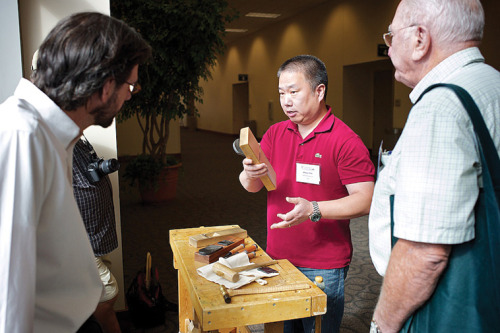As many of you already know, our own Wilbur Pan caused a bit of commotion in Kentucky last October while giving Christopher Schwarz some pointers on Japanese planes during a break at Woodworking In America. The following article appeared in the December 2010 Issue of Popular Woodworking, and we got permission from Popular Woodworking to reprint the article on our website. Nice job Wilbur!
========

I just spent three days teaching hand-tool techniques at our Woodworking in America conference and my staff members are now trying to keep their eyes open long enough to get this issue looking good, reading correctly and in your mailbox.
During my three days at Woodworking in America I talked until my voice was hoarse, answering questions about router planes (which Roy Underhill coined the “One-Tooth Sex Monster” plane), workbenches, saws, chisels and scrapers. But what was most amazing about the conference was how much I learned when I shut my mouth.
I am a confessed moron about Japanese planes, and I’ve been hesitant to set up a Japanese plane that was a gift from a friend. But when I found out that Wilbur Pan, a New Jersey doctor, was attending Woodworking in America, I asked him to give me a lesson in Japanese planes. He agreed.
On my lunch break Saturday we dragged a workbench into a hallway below an enormous window facing the 19th-century streetscape of Covington, Ky. Pan explained the fine points of seating the iron into the wooden body (called the dai) and showed me how to adjust the wooden bed to get the iron fitting properly.
While we were talking, other attendees began watching Pan’s mini-lecture. A blogger began filming the event. Soon everyone was getting into the act. Attendees were giving the planes a try. Pan was explaining how Japanese planing stops were different and I was thinking of ways to hollow out the sole of my dai.
And that’s when tool collector Tony Murland and woodworking legend Frank Klausz walked up and started listening. I could tell that Pan was a little nervous. He had started out explaining Japanese planes to just one guy. But now he had a high-powered audience that was growing by the moment. After Pan finished, Klausz added that he had heard that Japanese woods were softer than American woods – that’s why the tools were different.
Pan took a deep breath, and he politely disagreed with Klausz. I could hear a slight tremor in Pan’s voice as he explained that Japanese furniture was made from a wide variety of woods, including species that were very hard. Klausz listened thoughtfully and nodded his head.
It was an amazing moment for me, seeing this amateur woodworker hold his ground and explain the things he had learned to Klausz. But I knew that this was just one of the hundreds of amazing moments occurring everywhere at Woodworking in America. By the end of the weekend, attendees had also managed to show me a better way to mark hinge mortises and cut rabbets with a chisel.
I just hope that I showed them a few things myself. PWM
——————
Christopher Schwarz
Editor
Popular Woodworking Magazine
4700 E. Galbraith Road, Cincinnati, OH 45236